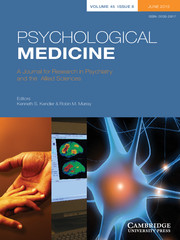Review Article
Depression in Gulf War veterans: a systematic review and meta-analysis
-
- Published online by Cambridge University Press:
- 20 February 2015, pp. 1565-1580
-
- Article
- Export citation
Original Articles
Population-based, multi-generational family clustering study of social anxiety disorder and avoidant personality disorder
-
- Published online by Cambridge University Press:
- 12 September 2014, pp. 1581-1589
-
- Article
- Export citation
Borderline personality disorder, but not euthymic bipolar disorder, is associated with a failure to sustain reciprocal cooperative behaviour: implications for spectrum models of mood disorders
-
- Published online by Cambridge University Press:
- 20 February 2015, pp. 1591-1600
-
- Article
- Export citation
Association between phthalates and externalizing behaviors and cortical thickness in children with attention deficit hyperactivity disorder
-
- Published online by Cambridge University Press:
- 12 November 2014, pp. 1601-1612
-
- Article
- Export citation
Do negative symptoms of schizophrenia change over time? A meta-analysis of longitudinal data
-
- Published online by Cambridge University Press:
- 26 November 2014, pp. 1613-1627
-
- Article
- Export citation
Neurocognitive and familial moderators of psychiatric risk in velocardiofacial (22q11.2 deletion) syndrome: a longitudinal study
-
- Published online by Cambridge University Press:
- 14 November 2014, pp. 1629-1639
-
- Article
- Export citation
Effects of depression co-morbidity and treatment on quality of life in patients with acute coronary syndrome: the Korean depression in ACS (K-DEPACS) and the escitalopram for depression in ACS (EsDEPACS) study
-
- Published online by Cambridge University Press:
- 21 November 2014, pp. 1641-1652
-
- Article
- Export citation
Risk factors for major depression during midlife among a community sample of women with and without prior major depression: are they the same or different?
-
- Published online by Cambridge University Press:
- 24 November 2014, pp. 1653-1664
-
- Article
- Export citation
Psychotic reactions to daily life stress and dopamine function in people with severe hearing impairment
-
- Published online by Cambridge University Press:
- 08 December 2014, pp. 1665-1674
-
- Article
- Export citation
Dimensional structure of bodily panic attack symptoms and their specific connections to panic cognitions, anxiety sensitivity and claustrophobic fears
-
- Published online by Cambridge University Press:
- 08 December 2014, pp. 1675-1685
-
- Article
- Export citation
The structure and short-term stability of the emotional disorders: a dimensional approach
-
- Published online by Cambridge University Press:
- 12 December 2014, pp. 1687-1698
-
- Article
- Export citation
Age-specific suicide mortality following non-fatal self-harm: national cohort study in Sweden
-
- Published online by Cambridge University Press:
- 26 November 2014, pp. 1699-1707
-
- Article
- Export citation
Polygenic risk, stressful life events and depressive symptoms in older adults: a polygenic score analysis
-
- Published online by Cambridge University Press:
- 09 December 2014, pp. 1709-1720
-
- Article
- Export citation
Childhood somatic complaints predict generalized anxiety and depressive disorders during young adulthood in a community sample
-
- Published online by Cambridge University Press:
- 18 December 2014, pp. 1721-1730
-
- Article
- Export citation
Prefrontal hypoactivation during working memory in bipolar II depression
-
- Published online by Cambridge University Press:
- 10 March 2015, pp. 1731-1740
-
- Article
- Export citation
Cognitive performance and the course of depressive symptoms over 7 years of follow-up: the SMART-MR study
-
- Published online by Cambridge University Press:
- 11 December 2014, pp. 1741-1750
-
- Article
- Export citation
Hypersomnia subtypes, sleep and relapse in bipolar disorder
-
- Published online by Cambridge University Press:
- 17 December 2014, pp. 1751-1763
-
- Article
- Export citation
Is avolition in schizophrenia associated with a deficit of dorsal caudate activity? A functional magnetic resonance imaging study during reward anticipation and feedback
-
- Published online by Cambridge University Press:
- 12 January 2015, pp. 1765-1778
-
- Article
-
- You have access
- Open access
- HTML
- Export citation
Prenatal marijuana exposure, age of marijuana initiation, and the development of psychotic symptoms in young adults
-
- Published online by Cambridge University Press:
- 23 December 2014, pp. 1779-1787
-
- Article
- Export citation
Front Cover (OFC, IFC) and matter
PSM volume 45 issue 8 Cover and Front matter
-
- Published online by Cambridge University Press:
- 27 April 2015, pp. f1-f2
-
- Article
-
- You have access
- Export citation

